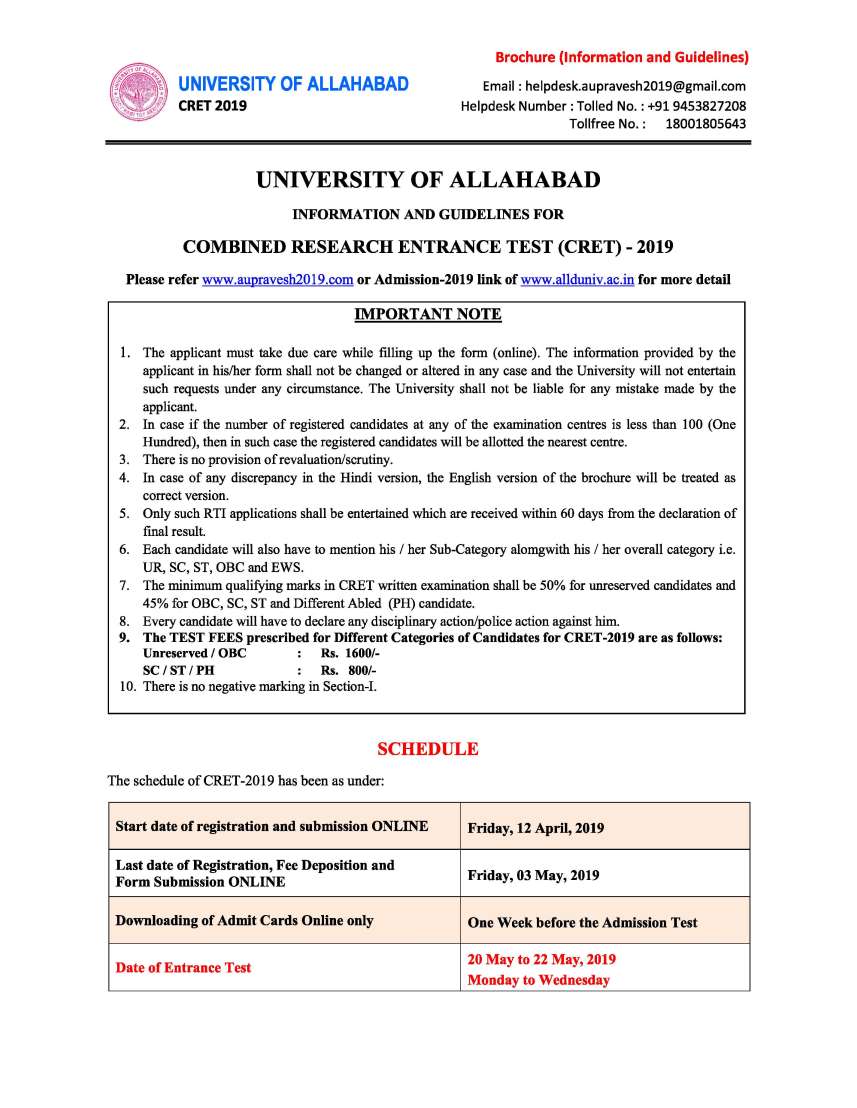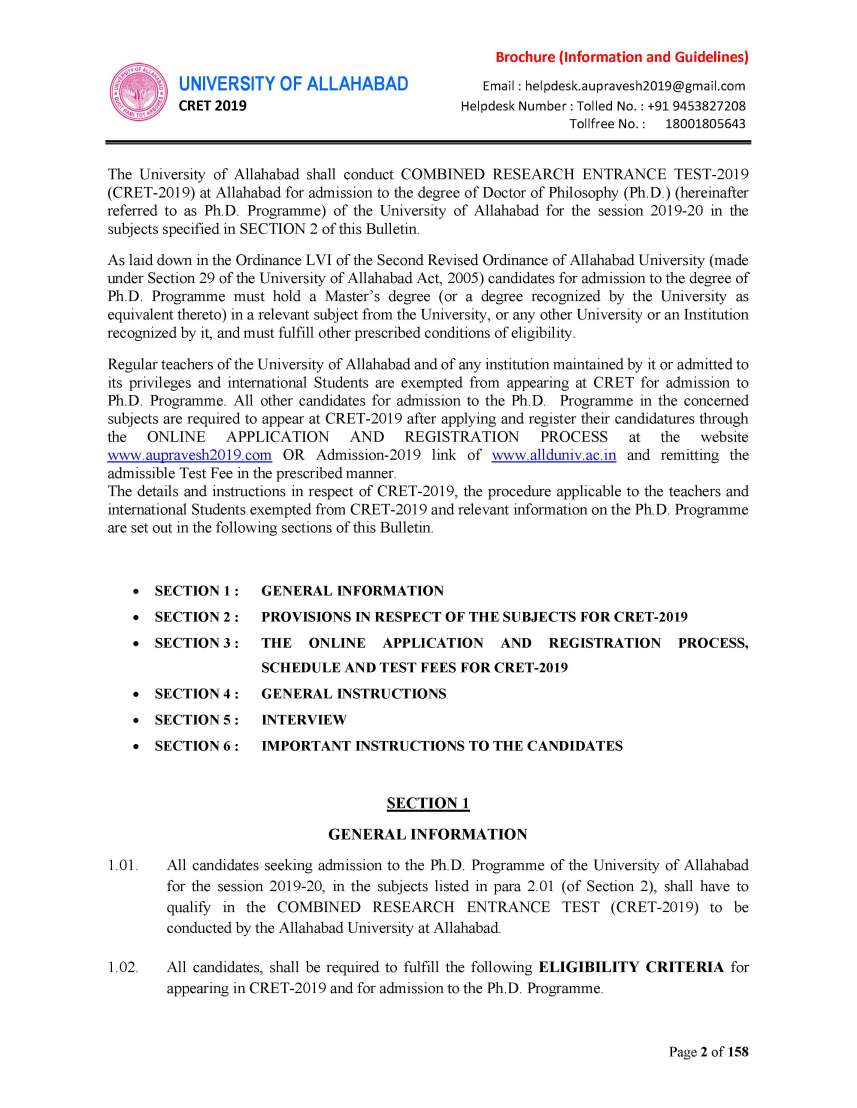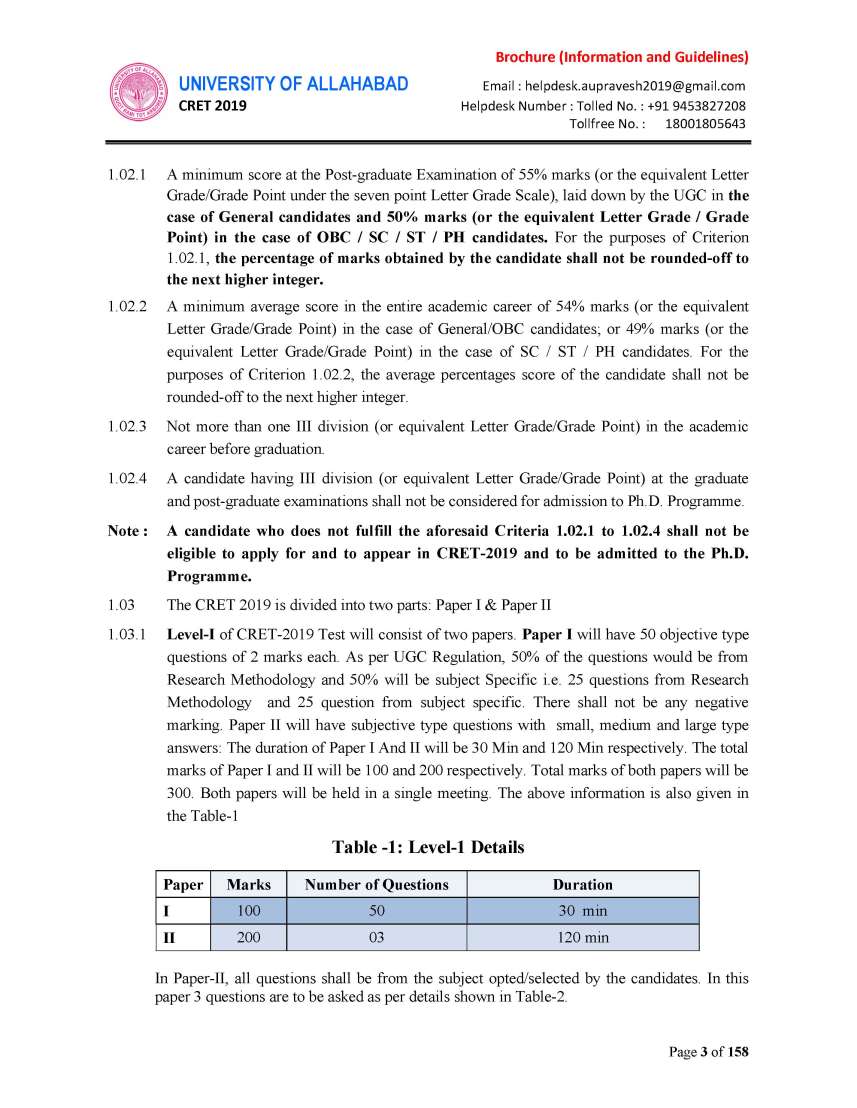| Re: Allahabad University CRET Question Paper
The syllabus of the subject - Agricultural-Botany on which the question paper of Combined Research Entrance Test (CRET) is based, is as follows:
AGRICULTURAL-BOTANY
Historical, symptomology, properties and nature of plant viruses, modes of transmission of plant viruses, serology and mutations in plant viruses General principal of control of virus diseases in plants. A knowledge of the common virus diseases of potato, tobacco, Hibiscus crcurbits, beans and banana.
- A knowledge of more important bacterial diseases with special reference to crown gall, citus canker, fire blight of pear, sugarcane stripe and bacterial wilt of crops.
- History of Mycology, Taxonomy and nomenclature of fungi Origin of phylogeny of fungi. Different systems of classification and their basis Physiology of fungi, structure and life history of the chief representatives of fungi
- Cell division: Mitosis and meiosis, chromosomal aberrations, use of chromosomal aberration in genetical studies. Morphology and chemistry of the chromosome
- Polyploidy: Nature and classification of polyploidy cytology and genetics of polyploids.
- Heredity and environment, laws of heredity. Linkagecrossing over and mapping of chromosomes The nature of the gene Physical structure of the gene, interaction penetrance and expressivity, position effect, pleiotropism, allelism multiple alleles and pseude alleles
- Gene in population, quantitative inheritance and cytoplasmic inheritance.
- Determination of sex, evolution of sex in flowing plants.
- Mutation: Nature and cause, factors affecting mutation. Genetics of sterility and incompatibility Genetics of species and race formation
- History of plant breeding, its present status and scope. Mode of reproduction in crop plants Heretosis and its application
- Plant introduction and its utility in crop improvement General methods of crop improvement.
- Regional soils of India in relation to crops and their production.
- Characteristics of root systems. Drought resistance, chemical control of water relations
- Concept of water requirement of crops and the critical period of water requirement of plants and its significance in crop production.
- Formation of usar soils and types of usar. Control of alkalinity and salinity
- Growth, methods of growth analysis, control of growth by hormones, mechanism of action of growth regulators, control of differentiation, flowering, dormance and senescence.
- Physiology of flowering, photoperiodism and vernalization.
- Origin, history, breeding and production technology of important fruits such as mango, banana, citrus, guava, papaya, grape, pineapple, litchi, pomegranate, ber, apple, pear, and walnut with special reference to climate, soil, propagation, cultivars, nutrition, irrigation and other orchard management practices.
- Origin, history, breeding and production of important vegetables, spices and condiments like tomato, brinjal, chillies, radish, turnip, carrot, beans, peas, onion, potato, okra, cucurbits, coriander, garlic, etc. with special reference to climate, soil, seed production including development of hybrids, cultivars, nutrition, irrigation and other management practices.
- History of gardening in India. Styles of gardening, their principles and practices with special reference to Nunghal, Japanese and English gardens Garden parts (features), their materials and methods of development including garden ornaments Classification and utilization of ornamental trees, shrubs, climbers, herbaceous, perennials, annuals and foliage plants Preparation and management Bonsai Home gardens Production of important flower crops like orchids, marigold, chrysanthemum, rose, jasmine, dahlia, with reference to climate, soil, propagation, cultivars, planting methods, nutrition, irrigation etc. Prolonging, storage and vase life of cut flowers and their utilization
- A study of the botany of important weeds associated with the crops plants of the region. Methods of preventing introduction and spread of weeds Principles and procedures of weed control.
- Concept of crop ecology and its scope in agronomic pursuits. Plant succession, units of vegetation competition and invasion, reaction and stabilization, factors of habitat and development.
- Light a factor in geographical distribution, heating, chemical, quantitative and qualitative effects. Latitude and length of day photocritical periods, photoperiodism and plant adaptations Utilization of artificial light
- Soil microorganisms and their role in production. Principles and practices of dry farming; special problems in dryrming Mixed-cropping and strip cropping in agriculture in India Agronomic practices in relation to soil acidity and alkalinity
- Floral biology, mode of reproduction, sporogenesis, pollination, fertilization, embryogenesis, fruit and seed development. Apomixis, parthenocarpy, polydembryony and somatic embryoids Seed structure of monocot and dicot Chemical composition of seeds Seed dormancy types, causes, mechanisms in induction and release, factors affecting, methods to overcome, dormancy, and significance in agriculture
- Principles of seed processing. Seed drying- principles and methods. Pre-cleaning, grading, treating and packaging
- Need for storage. Storage behaviour of orthodox Factors affecting seed storage and role of moisture, temperature, RH and moisture equilibrium Storage structure Methods of stacking and their impact. Germplasm storage
- Detailed study of photosynthesis and role of carbon assimilation in crop production.
- Respiration, respiratory substrates, factors affecting respiration, aerobic and alcoholic fermentation and their interrelationships, metabolisms of organic acids.
- Metabolism of fats.
- Physiological basis of purnning, lodging unfruitfulness and yield. Factors affecting: root ratio.
- Special physiological problems connected with crops like sugarcane, cotton, hemp, wheat, tobacco, rice, groundnut etc.
- Frequency distribution, mean, medium and mode, standard, normal and binomial distribution. Correlation- partial and multiple regression, coefficient Tests of significance- t, f and chi squaretests
- Chromosomal crossing over, linkage maps, double crossing over coincidence and interference; test crosses, evidence that crossing over is associated with chromosomal exchange factors affecting crossing over polyploids, and inversions. Male dresophila crossing by breakage of chaismata chaismata terminalizatiion, multiple allelism, pseudoallels, position, mutation rates, mutator genes, radiation and chemical-induced mutations. Mechanism of induction of chromosomal structural changes paramutation
- Structure and replication of DNA and RNA, DNA theory as the classical basis of heredity. Recombination in microorganisms structure of gene. Molecular aspects of chromosome structure Molecular aspects of mutation and recombi Genetic code and genetic control of protein synthesis Control of differentiation
- Breeding for disease and pest resistance, host parasite relationship, concept of horizontal and vertical resistance. Polypoloidy in plant breeding, breeding behaviour of aneuploids, autopolyploids, allopolyplnids and role in induced polyploids, Macro- and micromutations and plant breeding for drought resistance, lodging resistance, drarfing genes plant type rained conditions saline resistance and coln resistance Release of new varieties, multiplication and distribution, seed certification, seed labelling and testing maintenance of pure seed stocks Statistical methods and experimental designs for plant breeding experiments Cytogenetics and improvement work done in India on wheat, rice sugarcane, cotton, potato and mustard Frequency distribution, mean, medium and made. Tests of significance-t, f and chi-square tests Experimental designs, basic principles Completely Randomized, Randomized block. Latin square, split plot.
- Black tip of mango, chlorosis and sun scald.
- Physiology of penetration and infection in fungi Pathogen factors in the physiology of disease- toxins, enzymes and other metabolies Factors governing resistance and suscrptibility of the host of disease.
- Influence of environmental factors on plant diseases Epiphyhtotics and conditions necessary for its establishment. Physilogical specialization in parasitic fungi Forecasting of plant disease
- A detailed study of important bacterial, viral, mycoplasma and fungoid diseases of wheat barley; oat rice, pea, gram, maize, jowar, bajara potato, tobacco, colocasia, chilli, brassica and alied plants, groundnut, linseed, cotton sugarcane, mango guava, papaya, apple, peach, pear, cucurbits and banana.
- A study of the economically important flowering parasites.
- Orobanche, Cuscuta, Striga, Loranthus and Biscum.
- Important Nematode diseases of plants.
- Quarantines and prohibitions; general idia of quarantine regulations in force in India and Uttar Pradesh.
- Crop rotation, field sanitation, eliminations of alternate hosts; chemical eradication.
|



